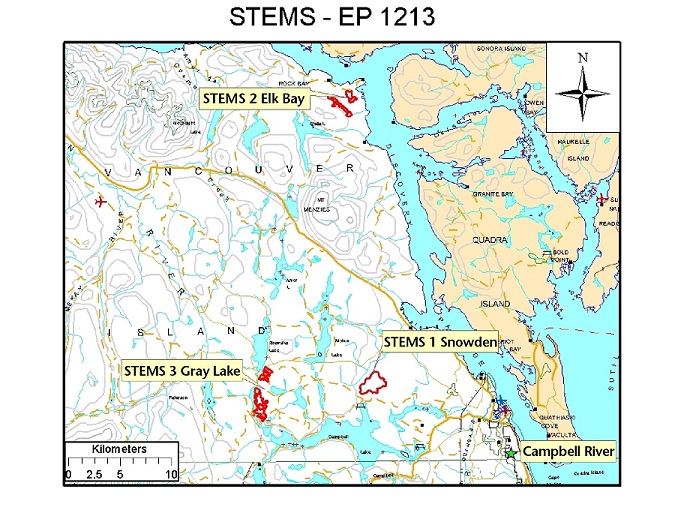Silviculture Treatments for Ecosystem Management in the Sayward (STEMS)
Silviculture Treatments for Ecosystem Management in the Sayward (STEMS) is a large-scale, multi-disciplinary experiment that compares forest productivity, economics, and public perception of seven silvicultural systems or extended rotation treatments, replicated at three sites in the Sayward Forest on Vancouver Island.
The overall goals of the STEMS experiment are, within mature second-growth Douglas-fir or western hemlock stands:
- To create replicated examples of alternative harvest practices and silvicultural regimes that can be used as a demonstration area by foresters and planners in ecosystem management
- To provide quantitative information for evaluation of feasibility and costs of alternative regimes and of their long-term effects on production of timber volumes and values and other non-timber values
- To evaluate the effectiveness of contrasting silvicultural systems in reducing environmental and visual impacts of forestry operations, while supplying high timber outputs over time
The results of this experiment will be used to improve forest management and policies because results can be directly interpreted operationally due to the large-scale, replicated experimental design. The information will be especially relevant for ecosystem management of forests with multiple objectives.
The silvicultural systems tested at STEMS
Silvicultural systems are defined as planned programs of silviculture treatments designed to achieve specific stand structure objectives during the entire life of the stand. The STEMS experiment uses silvicultural systems and extended rotation treatments to create diversity in forest structure that results in a variety of canopy layers (vertical structure) and spatial patchiness (horizontal structure) to enhance biodiversity and wildlife.
The seven different silvicultural systems and extended rotation treatments include:
- Modified patch cut
- Extended rotation (uncut control)
- Group selection
- Clearcut with reserves
- Uniform dispersed retention
- Extended rotation with commercial thinning
- Aggregated retention
These silvicultural systems create a range of gap sizes and frequencies that emulate natural variation in forest structure. This is consistent with the goals of ecosystem management, which are to sustain diversity in the structure, composition, and function of entire ecosystesm.
STEMS locations

There are three replications of the STEMS experiment located in the Sayward Landscape Unit of the Campbell River Natural Resource District on Vancouver Island, B.C:
- STEMS 1: located in the Snowden Demonstration Forest, was harvested in 2001 in partnership with B.C. Timber Sales. The stand was a planted but unmanaged stand of Douglas-fir. A Self-Guided Walking Tour at STEMS 1 provides an introduction to the experiment. Click on the map above to start the walking tour of the STEMS 1 Experiment site or go to STEMS driving directions
- STEMS 2: located south of Elk Bay, was harvested in 2005 in partnership with International Forest Products
- STEMS 3: located east of Gray Lake, was harvested in 2008 in partnership with B.C. Timber Sales
STEMS was established as a replication of the Silvicultural Options for Harvesting Young-Growth Production Forests in the Capitol Forest near Olympia, Washington.
